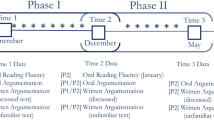Abstract
Studies from many countries report that secondary school students do not master written argumentation well enough. This article presents a case study from lower secondary school where the question of problems in written argumentation is approached from a different angle: instead of focusing on argumentative weaknesses in student texts, it concentrates on what students are capable of and struggle with when they write argumentative texts in cooperation with a scaffolding teacher. Findings from this study show that a clear text pattern communicated through teaching and teacher response helped weak as well as strong writers to improve common problems related to audience awareness and the structure of argumentative texts. In cooperation with a commenting teacher all students were also able to support a standpoint with more reasons and to strengthen their own position by refuting a counterargument, although to varying degrees. However, only a couple of revised texts suggest that students had the will, skill and insight needed to follow up teacher response that encouraged a more distanced view on heated debates, conflict negotiations, self-reflection and critical thinking.
Similar content being viewed by others
Notes
The names of the school, students, and teacher are pseudonyms. “Dalen”, “the valley”, is a common Norwegian name, indicating that this is a school in a rural area.
At the end of lower secondary school (year 10) students sit for two 5-h exams, writing texts in two official written standards of the Norwegian language, and now also in two different modes.
References
Andrews, R. 1995. Teaching and learning argument. London: Cassell.
Andrews, R. 2005. Models of argumentation in educational discourse. Text 25(1): 107–127.
Andrews, R. and S. Mitchell. 2001. Essays in argument. Middlesex: Middelsex University Press.
Andrews, R., P. Costello, and S. Clarke. 1993. Improving the quality of argument, 5–16: Final report. Hull: University of Hull, School of Education, Centre for Studies in Rhetoric.
Andrews, R., C. Torgerson, G. Low, N. McGuinn, and A. Robinson. 2006. Teaching argumentative non-fiction writing to 7–14 year olds: A systematic review of the evidence of successful practice. Technical report. London: EPPI-Centre, Social Science Research Unit, Institute of Education, University of London.
Andrews, R., C. Torgerson, G. Low, and N. McGuinn. 2009. Teaching argument writing to 7–14 year olds: An international review of the evidence of successful practice. Cambridge Journal of Education 39: 3.
Bakhtin, M.M. 1986. The problem of speech genres. In Speech genres and other late essays, ed. C. Emerson, and M. Holquist (trans: McGee, V.W.), 62–102. Austin: University of Texas Press.
Berge, K.L. 2005. Studie 6: Tekstkulturer og tekstkvaliteter. In Ungdommers skrivekompetanse. Bind II: Norskeksamen som tekst, ed. K.L. Berge, L.S. Evensen, F. Hertzberg, and W. Vagle, 11–190. Oslo: Universitetsforlaget.
Berge, K.L., Evensen, L.S., Hertzberg, F. and W. Vagle. 2005. Ungdommers skrivekompetanse. Bind I og II. Oslo: Universitetsforlaget.
Clark, H.H. 1996. Using language. Cambridge: Cambridge University Press.
Evensen, L.S., and W. Vagle. 2005. Oppgavesettene og elevenes oppgavevalg i KAL-årene. In Ungdommers skrivekompetanse. Bind I: Norsksensuren som kvalitetsvurdering, ed. K.L. Berge, L.S. Evensen, F. Hertzberg, and W. Vagle, 161–203. Oslo: Universitetsforlaget.
Freedman, A., and I. Pringle. 1984. Why students can’t write arguments. English in Education 18(2): 73–84.
Groom, N. 2000. “A workable balance”: Self and sources in argumentative writing. In Learning to argue in higher education, ed. S. Mitchell, and R. Andrews, 65–73. Portsmouth, NH: Heinemann-Boynton/Cook.
Hertzberg, F. 2006. Genreskriving under senare skolår: att berätte räcker inte. I Louise Bjar (red.): Det hänger på språket! Lärande och språkutveckling i grundskolan, 295–317. Lund: Studentlitteratur.
Hoey, M. 1983. On the surface of discourse. London: George Allen & Unwin.
Igland, M.-A. 2008. Mens teksten blir til: Ein kasusstudie av lærarkommentarar til utkast. Oslo: Unipub.
Larsson, K. 1984. Skrivförmåga. Studier i svenskt elevspråk. Malmø: Liber.
Linell, P. 1998. Approaching dialogue: Talk, interaction and contexts in dialogical perspective. Amsterdam: John Benjamins.
O’Rourke, P., and M. O’Rourke. 1995. Argumentative writing and the extension of literacy. In Competing and consensual voices: The theory and practice of argument, ed. P. Costello, and S. Mitchell, 194–207. Clevedon, UK: Multilingual Matters.
Phelps, L.W. 2000. Cyrano’s nose: Variations on the theme of response. Assessing Writing 7(1): 91–110.
Pringle, I., and A. Freedman. 1985. A comparative study of writing abilities in two modes at the grade 5, 8 and 12 levels. Toronto: Ontario Ministry of Education.
Purves, A.C. 1992. A comparative perspective on the performance of students in written composition. I d.s. (red.). The IEA study of written composition II: Education and performance in fourteen countries, 129–152. Oxford: Pergamon Press.
Tirkkonen-Condit, S. 1985. Argumentative text structure and translation. Studia Philologica Jyväskylänsia 18.
Toulmin, S.E. 2003. The uses of argument, 2nd ed. Cambridge: Cambridge University Press.
van Eemeren, F.H. 2001. The state of the art in argumentation theory. In Critical concepts in argumentation theory, ed. F.H. van Eemeren, 11–26. Amsterdam: Amsterdam University Press.
Vygotskij, L.S. 1987. Thinking and speech. In The collected works of L. S. Vygotsky: Volume I: Problems of general psychology, ed. R.W. Rieber, and A.S. Carton, 39–288. New York: Plenum.
Young, R.E. 2003. Toward an adequate pedagogy for rhetorical argumentation: A case study in invention. In Beyond postprocess and postmodernism. Essays on the spaciousness of rhetoric, ed. T. Enos, and K.D. Miller, 159–169. Mahwah, NJ: Lawrence Erlbaum Associates.
Author information
Authors and Affiliations
Corresponding author
Rights and permissions
About this article
Cite this article
Igland, MA. Negotiating Problems of Written Argumentation. Argumentation 23, 495–511 (2009). https://doi.org/10.1007/s10503-009-9167-6
Accepted:
Published:
Issue Date:
DOI: https://doi.org/10.1007/s10503-009-9167-6




